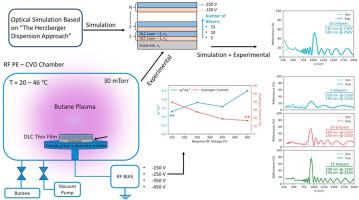周期性改变射频电压产生多层DLC薄膜的光学行为:实验和理论模型
IF 4.2
3区 材料科学
Q2 MATERIALS SCIENCE, MULTIDISCIPLINARY
引用次数: 0
摘要
类金刚石(DLC)薄膜通常用作激光导引头和红外传感器的环境效应保护层和光学滤光片。DLC薄膜的sp2/sp3键比影响其光学性能。因此,如果将DLC薄膜堆叠成具有不同sp2/sp3键结构的层,则可以在电磁波谱的红外区域将薄膜的反射率和透射率调谐到特定波长。在本研究中,采用射频PE-CVD技术将DLC薄膜沉积在具有超低热膨胀系数的硅和玻璃衬底上。在研究的第一步,在不同的射频电压(−150V到−450V)下制作单层DLC薄膜。利用拉曼光谱和XPS技术对不同偏压下制备的薄膜的键合特性进行了表征。利用XPS和拉曼光谱技术测定了sp2/sp3比和氢含量。研究了电磁波谱可见光区和近红外区的折射率(n)和消光系数(k)。基于“赫兹伯格色散方程”方法的光学模型也被使用。基于该模型的实验和仿真结果进行了比较,验证了理论方法的正确性。多层膜的层数对调谐中心波长的反射强度有重要影响。层的厚度改变了光谱的中心波长。本文章由计算机程序翻译,如有差异,请以英文原文为准。

Optical behavior of multilayer DLC films produced by periodically altered RF voltage: Experimental and theoretical model
Diamond-like carbon (DLC) films are generally used as protective layers for environmental effects and optic filters in laser seekers and infrared sensors. The sp2/sp3 bond ratio of DLC films affects their optical properties. Therefore, if the DLC films are formed as a stack of layers with different sp2/sp3 bond structures, the reflectance and transmittance of the film can be tuned to a specific wavelength in the infrared region of the electromagnetic spectrum.
In this study, DLC thin films were deposited on silicon and glass substrates with ultra-low thermal expansion coefficient by using RF PE-CVD technique. In the first step of the study, single-layer DLC films were produced with different RF voltages (from −150V to −450V). The bond characteristics of the produced films with different bias voltages were characterized by Raman Spectroscopy and XPS techniques. The sp2/sp3 ratios and hydrogen contents were measured by using XPS and Raman Spectroscopy techniques. The refractive index () and extinction coefficient () were investigated in the visible and NIR regions of the electromagnetic spectrum. An optical model based on the “Herzberger Dispersion Equation” approach was also utilized. The experimental and simulation results based on the model were compared to justify the theoretical approach. The number of layers had a critical role in the reflection intensity of the tuned center wavelength of the multilayer films. The thickness of the layers had shifted the center wavelength in the spectrum.
求助全文
通过发布文献求助,成功后即可免费获取论文全文。
去求助
来源期刊

Optical Materials
工程技术-材料科学:综合
CiteScore
6.60
自引率
12.80%
发文量
1265
审稿时长
38 days
期刊介绍:
Optical Materials has an open access mirror journal Optical Materials: X, sharing the same aims and scope, editorial team, submission system and rigorous peer review.
The purpose of Optical Materials is to provide a means of communication and technology transfer between researchers who are interested in materials for potential device applications. The journal publishes original papers and review articles on the design, synthesis, characterisation and applications of optical materials.
OPTICAL MATERIALS focuses on:
• Optical Properties of Material Systems;
• The Materials Aspects of Optical Phenomena;
• The Materials Aspects of Devices and Applications.
Authors can submit separate research elements describing their data to Data in Brief and methods to Methods X.
 求助内容:
求助内容: 应助结果提醒方式:
应助结果提醒方式:


